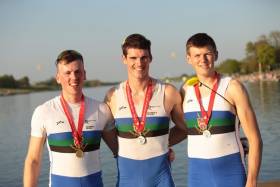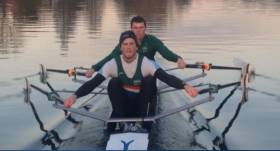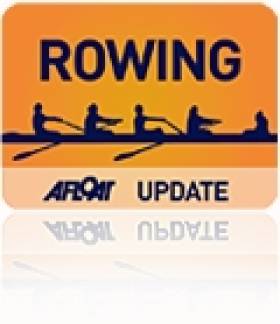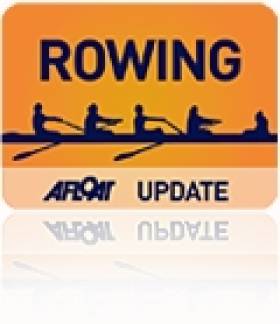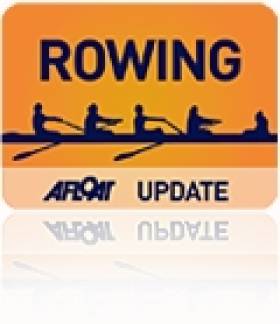Displaying items by tag: Queen's University
Queen's in the Medals at BUCS Rowing Regatta
#Rowing: Queen’s University, Belfast, launched a very successful raid on the medals available on the first two days of the BUCS Regatta in Nottingham.
Queen’s had a very successful Saturday. They won the Beginners’ coxed four, and their talented group of scullers also shone. Philip Doyle took silver in the Championship single, while Sam McKeown took fourth. In the intermediate single, Queen’s took gold and silver, through Tiernan Oliver and Nathan Hull.
This foursome were again on song on Sunday. McKeown and Doyle took silver in the Championship double, and Hull and Oliver matched them. Fiona Bell also made the podium in the women’s Championship single scull, taking bronze.
BUCS (British University) Regatta, Nottingham (Selected Results; Irish interest)
Saturday
Men, Four – Beginners’, coxed: 1 Queen’s 7:10.49.
Sculling, Single – Championship: 1 Edinburgh (J Armstrong) 7:20.99, 2 Queen’s (P Doyle) 7:22.01; 4 Queen’s (S McKeown) 7:27.73. Intermediate: 1 Queen’s (T Oliver) 7:37.48, 2 Queen’s (N Hull) 7:37.66.
Sunday
Men, Sculling, Double – Championship: 1 Reading 6:40.76, 2 Queen’s 6:43.56. Inter: 1 Reading 6:55.04, 2 Queen’s 7:00.91.
Women
Sculling, Single – Championship: 1 Edinburgh 8:09.20; 3 Queen’s 8:26.50.
Lightweight Queen's Crew Fastest at Shannon Rowing
#Rowing: A young Queen’s University lightweight quadruple were the fastest crew at the Shannon Head of the River at Carrick-on-Shannon on Saturday. The under-23 crew of Jordan Wilson, Miles Taylor, Ewan Murray and Harry Mahon took 11 minutes and 53 seconds to complete the course. Portora’s junior 16 eight also did well. Tiernan Oliver and Sam McKeown, in a senior double, almost matched their time. See Attached Results.
Head of the Shannon, Carrick-on-Shannon (Selected Results)
Head One:
Men
Eight – Jun 16: Portora 12 minutes 43 seconds.
Four – Jun 18, coxed: Portora 13:13.
Sculling, Quadruple – Jun 16, coxed: Carrick-on-Shannon 14:24. Double – Sen: Queen’s 12:46
Women
Eight – Club One: Commercial 14:29. Jun 18: Commercial 13:39
Sculling, Quadruple – Jun 18A: Portora 14:08.
Head Two:
Men
Eight – Novice: Commercial 14:55.
Sculling – Quadruple – Sen: Queen’s 11:53. Jun 18A, coxed: Portora 12:28
Single – Sen: Queen’s (T Oliver) 14:03. Jun 18A Carrick-on-Shannon (T Earley) 14:48.
Women
Eight – Inter: Commercial B 13:40. Jun 16: Portora 13:57.
Queen's Senior Eight Fastest at Bann Head of the River
#Rowing: Queen’s Univerity’s senior men’s eight, competing in the first of two races, were far and away the fastest crew at the Bann head of the river at Coleraine on Saturday. The host club’s own junior coxed four was the fastest in the second head, with single sculler Sam McKeown recording the second-best time. The strong winds of recent days held off for the two races.
Bann Head of the River, Coleraine, Saturday (adjusted times)
Race One: 1 Queen’s University men’s senior eights 13 mins 39 secs, 2 Belfast BC masters eight 16:06, 3 Belfast RC masters eight 16:15, 4 Bann masters eight 16:35, 5 RBAI junior 18 quad 16:38, 6 Portadown senior double 16:50.
Race Two: Bann junior 18 coxed four 15:25, 2 Portadown senior single (S McKeown) 17:29, Bann inter single (Mitchell) 17:35, 4 Queen’s A women’s inter four 17:49, 5 Queen’s B women’s inter four 17:58, 6 Lady Elizabeth masters single (Smyth) 18:06.
| BANN ROWING CLUB HEAD OF THE RIVER | 14TH NOVEMBER 2015 | |||
| RACE 1 | ||||
| Place | Boat Number | Club | Category and Boat | adjusted time taken |
| 1 | 1 | QUBBC | M Sen 8+ | 00:13:39 |
| 2 | 13 | Belfast BC (f) | MM 8+ | 00:16:06 |
| 3 | 12 | Belfast RC (e) | MM 8+ | 00:16:15 |
| 4 | 11 | Bann RC(c) | MM 8+ | 00:16:35 |
| 5 | 3 | RBAI A | MJ18A 4X- | 00:16:38 |
| 6 | 5 | Portadown BC | M Sen 2X | 00:16:50 |
| 7 | 6 | Bann RC | W Int 4X- | 00:17:18 |
| 8 | 14 | LVBC (f) | MM 8+ | 00:17:20 |
| 9 | 2 | RBAI | MJ18A 8+ | 00:17:25 |
| 10 | 24 | Belfast BC (d) | WM 8+ | 00:17:36 |
| 11 | 17 | Bann RC | W J18A 4X- | 00:18:18 |
| 12 | 22 | Bann RC | MJ16 2X | 00:19:02 |
| 13 | 16 | City of Derry BC (e) | MM 2X | 00:19:23 |
| 14 | 18 | Belfast RC | W J18A 4X- | 00:19:27 |
| 15 | 25 | Belfast RC (c) | WM 8+ | 00:20:01 |
| 16 | 23 | Bann RC | WJ16 8+ | 00:20:03 |
| 17 | 4 | RBAI B | MJ18A 2X | 00:21:59 |
| 18 | 21 | Portadown BC | W Int 2X | 00:22:28 |
| 19 | 19 | Portadown BC | WJ18A 4X- | 00:23:15 |
| 20 | 29 | Portadown BC | WJ15 2X | 00:26:37 |
| 21 | 28 | City of Derry BC (c) | WM 2X | 00:26:48 |
| RACE 2 | ||||
| Place | Boat Number | Club | Category and Boat | adjusted time taken |
| 1 | 42 | Bann RC | MJ18A 4+ | 00:15:25 |
| 2 | 45 | Portadown McKeown | M Sen 1X | 00:17:29 |
| 3 | 47 | Bann Mitchell | M Int 1X | 00:17:35 |
| 4 | 53 | QUBLBC A | W Int 4- | 00:17:49 |
| 5 | 54 | QUBLBC B | W Int 4- | 00:17:58 |
| 6 | 58 | LEBC (c) Smith | MM 1X | 00:18:06 |
| 7 | 64 | Portadown BC | MJ16 4X+ | 00:18:18 |
| 8 | 57 | Portora (e) Murphy | MM 1X | 00:18:29 |
| 9 | 51 | Belfast BC (f) | MM 4+ | 00:18:50 |
| 10 | 59 | City of Derry (e) D’Urso | MM 1X | 00:19:02 |
| 11 | 63 | City of Derry BC | MJ16 4X+ | 00:19:05 |
| 12 | 68 | Portadown BC | MJ15 4X+ | 00:19:40 |
| 13 | 50 | Portadown BC Laivins | M Int 1X | 00:19:41 |
| 14 | 60 | Belfast BC (d) Gilpin | MM 1X | 00:20:04 |
| 15 | 56 | Belfast RC B | W Int 4+ | 00:20:08 |
| 16 | 49 | Blue Star Gilliland | M Int 1X | 00:20:09 |
| 17 | 83 | Bann RC | WJ15 4X+ | 00:20:09 |
| 18 | 61 | Belfast BC (f) Lockwood | MM 1X | 00:20:14 |
| 19 | 76 | Bann RC Chestnutt | WJ18A 1X | 00:20:34 |
| 20 | 71 | Bann RC Shirlow | W Int 1X | 00:21:10 |
| 21 | 77 | Bann RC Meenagh | W Int 1X | 00:21:13 |
| 22 | 79 | Belfast RC Taylor | WJ18A 1X | 00:21:14 |
| 23 | 62 | LVBC (e) Keown | MM 1X | 00:21:26 |
| 24 | 81 | Bann RC Wylie | WJ18A 1X | 00:21:30 |
| 25 | 80 | Bann RC ODonovan | WJ18A 1X | 00:21:54 |
| 26 | 73 | Belfast RC Moran | MJ16 1X | 00:22:56 |
| 27 | 52 | Bann RC Cochrane | MJ18A 1X | 00:23:15 |
| 28 | 55 | Belfast RC A | W Int 4+ | 00:23:35 |
| 29 | 78 | Portadown BC Martin | W Int 1X | 00:24:40 |
| 30 | 84 | Portadown RC | WJ15 4X+ | 00:25:52 |
| 31 | 82 | Portadown BC McCann | WJ16 1X | 00:28:42 |
Queen's Coxless Four Top Rankings at Bann Head of the River
#BannRowingHead: Queen's University crews were the fastest at both heads in the Bann Head of the River in Coleraine. The Queen's men's intermediate coxless four set a time of 13 minutes and 19 seconds in the second head - just five seconds slower than the intermediate eight which won the first head. The fastest single sculler on the day was Brendan Smyth of Lady Elizabeth, the old boys' club of Trinity College.
| BANN HOR 2013 | FINAL RESULTS | RACE 1 | ||
|---|---|---|---|---|
| Adjusted | ||||
| Boat Number | Club | Category and Boat | Time | Time |
| 2 | QUBC | M INT 8+ | 00:13:14 | 00:13:14 |
| 1 | QUBC | M INT 8+ | 00:14:09 | 00:14:09 |
| 15 | BELFAST RC | MM 8+ E | 00:15:23 | 00:14:25 |
| 14 | BELFAST BC | MM 8+ E | 00:15:27 | 00:14:29 |
| 19 | LADY VICTORIA BC | MM 8+ F | 00:15:53 | 00:14:34 |
| 3 | RBAI | MJ18 8+ | 00:14:42 | 00:14:42 |
| 8 | BANN RC | MJ16 8+ | 00:14:42 | 00:14:42 |
| 5 | BANN RC | MJ18 4X- | 00:14:51 | 00:14:51 |
| 6 | CAI BC | MJ18 4X- | 00:14:56 | 00:14:56 |
| 9 | BANN RC | M INT 2X | 00:15:09 | 00:15:09 |
| 7 | CAI BC | MJ16 8+ | 00:15:16 | 00:15:16 |
| 12 | BANN RC | WJ18 8+ | 00:15:19 | 00:15:19 |
| 4 | CITY OF DERRY BC | MJ18 8+ | 00:15:21 | 00:15:21 |
| 18 | BANN RC | MM 8+ C | 00:15:51 | 00:15:29 |
| 13 | BANN/LADY ELIZ | MS 2- | 00:15:55 | 00:15:55 |
| 11 | QUB LADIES BC | W INT 8+ | 00:15:58 | 00:15:58 |
| 10 | PORTADOWN BC | M INT 2X | 00:16:01 | 00:16:01 |
| 25 | CITY OF DERRY BC | MM 2X E | 00:17:20 | 00:16:22 |
| 21 | CAI BC | MJ18 2- | 00:17:02 | 00:17:02 |
| 31 | QUB B BC | MNOV 8+ | 00:17:11 | 00:17:11 |
| 24 | CARLOW RC | MM 2X C | 00:17:46 | 00:17:24 |
| 26 | LADY VICTORIA BC | MM 2X E | 00:19:06 | 00:18:08 |
| 22 | CAI B BC | MJ18 2- | 00:18:14 | 00:18:14 |
| 28 | PORTADOWN BC | WJ18 4X- | 00:18:31 | 00:18:31 |
| 30 | QUB BC | MNOV 8+ | 00:18:38 | 00:18:38 |
| 27 | BELFAST RC | WM 8+ D | 00:19:25 | 00:18:44 |
| 32 | BELFAST RC | WNOV 8+ | 00:18:48 | 00:18:48 |
| 23 | BELFAST BC | MM 2X B | 00:18:55 | 00:18:48 |
| 34 | CAI BC | MJ15 2X | 00:19:23 | 00:19:23 |
| 36 | QUB BC | WNOV 8+ | 00:20:09 | 00:20:09 |
| 29 | PORTADOWN BC | WJ16 8+ | 00:20:11 | 00:20:11 |
| 35 | CITY OF DERRY BC | WJ16 2X | 00:23:40 | 00:23:40 |
| BANN HOR 2013 | FINAL RESULTS | RACE 2 | ||
| Adjusted | ||||
| Boat Number | Club | Category and Boat | Time | Time |
| 41 | QUB BC | MINT 4- | 00:13:19 | 00:13:19 |
| 44 | QUB BC | MINT 4+ | 00:13:45 | 00:13:45 |
| 45 | RBAI | MNOV 4X+ | 00:14:03 | 00:14:03 |
| 42 | CAI BC | MJ18 4- | 00:14:15 | 00:14:15 |
| 51 | BANN RC | MJ16 4X+ | 00:14:15 | 00:14:15 |
| 43 | CAI B BC | MJ18 4- | 00:14:21 | 00:14:21 |
| 53 | RBAI | MJ16 4X+ | 00:14:33 | 00:14:33 |
| 47 | CITY OF DERRY BC | MNOV 4X+ | 00:14:38 | 00:14:38 |
| 62 | CARLOW RC | MM 4+ C | 00:15:01 | 00:14:39 |
| 57 | PORTADOWN MCKEOWN | MINT 1X | 00:15:23 | 00:15:23 |
| 54 | CAI BC | MJ16 4+ | 00:15:24 | 00:15:24 |
| 58 | BANN RC MCAFEE | MINT 1X | 00:15:31 | 00:15:31 |
| 56 | BANN RC WHORISKEY | MINT 1X | 00:15:47 | 00:15:47 |
| 48 | CITY OF DERRY BC | MJ18 4+ | 00:15:59 | 00:15:59 |
| 59 | LADY ELIZ SMYTH | MS 1X | 00:15:59 | 00:15:59 |
| 74 | BANN RC | WJ15 4X+ | 00:16:04 | 00:16:04 |
| 61 | LADY VICTORIA BC | MM 4+ E | 00:16:19 | 00:15:21 |
| 72 | BANN RC | WJ16 4X+ | 00:16:47 | 00:16:47 |
| 65 | CAI BC | MJ15 4X+ | 00:16:49 | 00:16:49 |
| 55 | CAI B BC | MJ16 4+ | 00:16:50 | 00:16:50 |
| 60 | BANN RC LEVINS | MS 1X | 00:16:55 | 00:16:55 |
| 67 | CITY OF DERRY BC | MM 1X E | 00:16:58 | 00:16:00 |
| 73 | BELFAST RC | WJ15 4X+ | 00:17:03 | 00:17:03 |
| 70 | BANN RC BARRY | WJ18 1X | 00:17:10 | 00:17:10 |
| 46 | BELFAST RC | MNOV 4X+ | 00:17:19 | 00:17:19 |
| 66 | LAGAN SCULLERS | MM 1X C | 00:17:20 | 00:16:58 |
| 49 | QUB LADIES BC | WINT 4+ | 00:17:36 | 00:17:36 |
| 68 | LADY VICTORIA BC | MM 1X E | 00:18:04 | 00:17:06 |
| 52 | PORTADOWN RC | MJ16 4X+ | 00:18:08 | 00:18:08 |
| 69 | PORTADOWN RC | MJ18 1X | 00:18:37 | 00:18:37 |
| 71 | CITY OF DERRY BC | WJ18 1X | 00:20:57 | 00:20:57 |
Battling Performances Make Keohane and Lambe Champions
#IrishRowingChampionships: Claire Lambe and John Keohane won the men’s and women’s senior single sculls titles at the Irish Rowing Championships at Farran Woods in Cork today. Both had hard battles before crossing the line as winners.
Lambe had a disappointing start and saw Sinéad Jennings take and hold the lead until halfway. Lambe came back and led by 1500 metres, but Jennings mounted challenge after challenge.
Keohane took the lead early on but had to battle to retain it. Eimantas Grigalius, a World Junior Champion in 2003, drove hard a the Corkman through the closing 500 metres, but Keohane, rating below his opponent, retained his lead – and the title he won last year.
There was great excitement in the closing stages of the men’s novice coxed four. UCD’s lead was eaten away and then completely lost to Queen’s University, who won by .92 of a second. UCD also lost out in the women’s intermediate coxed four to a strong St Michael’s crew of Hannah McCarthy, Emily Tormey, Kate O’Brien, Hanah O’Sullivan and cox Conor McGowan.
The men’s intermediate pair and the women’s junior pair and men’s junior double sculls were convincingly won by UCC, Portora and Shandon respectively.
Irish Rowing Championships, National Rowing Centre, Farran Woods, Cork – Day Three (Selected Results, Finals)
Men
Four – Novice, coxed: 1 Queen’s 7:49.87, 2 UCD 7:50.79, 3 UCC 7:55.25.
Pair – Intermediate: 1 UCC 8:13.04, 2 Portora 8:36.82, 3 Bann 8:42.84.
Sculling, Double – Junior: 1 Shandon (J Casey, A Harrington) 7:55.13, 2 Skibbereen 8:13.06, 3 Lee 8:19.07.
Single – Senior: 1 Lee Valley (J Keohane) 8:00.96, 2 Three Castles (E Grigalius) 8:03.83, 3 Portadown (S McKeown) 8:21.55.
Women
Four, Intermediate, coxed: 1 St Michael’s 8:10.43, 2 UCD C 8:18.36, 3 UCD A 8:28.10.
Pair – Junior: 1 Portora (D Maguire, P Mulligan) 9:04.90, 2 Muckross 9:16.42, 3 Shannon 9:19.32.
Sculling, Single – Senior: 1 UCD (C Lambe) 9:09.20, 2 St Michael’s (S Jennings) 9:10.31, 3 Three Castles (H Walshe) 9:28.57.
Pre-Race Crash Rules Out Queen's at Lagan Head of the River
# ROWING: A collision before the start between the Queen’s University senior eight and the Portadown intermediate four took both crews out of the reckoning at the second head of the day at Lagan Head of the River in Belfast on Saturday. One of the Portadown crew had to be treated in hospital. In the absence of Queen’s, Neptune’s junior 18 eight ruled the waters: they took pennants as fastest crew; fastest junior crew and fastest junior 18 eight. The Belfast Boat Club/RBAI senior crew was the fastest four and Trinity's top women’s senior eight placed well.
| Lagan Head of the River 2013 - Race 2 – 4200m Saturday 16th February at 1500 |
|---|
| RESULTS by Time – Masters handicap not applied |
| POSITION |
| CREW |
| NUMBER Club Class Cox/Steerer Time % of winning |
| time Comments |
| 1 6 Neptune RC MJ18A 8+ H. Thompson 15:59.2 100.00 |
| 2 5 Portora BC MJ18A 8+ E. McClean 16:02.9 100.39 |
| 3 2 CAIBC MJ18A 8+ M. Bucklee 16:03.7 100.48 |
| 4 8 BBC/RBAIRC MS 4- A. Boreham 16:12.1 101.35 |
| 5 21 QUBBC A MN 8+ P. Ramsey 16:36.1 103.85 |
| 6 11 DULBC A WS 8+ G. Nic Fhionnain 16:43.1 104.58 |
| 7 20 BRC MN 8+ K. McCullagh 16:48.2 105.11 |
| 8 13 BBC MM E 8+ A. Scott 17:06.2 106.99 |
| 9 7 LSC MS 4X- P. Cross 17:10.8 107.46 |
| 10 31 Bann RC MJ16 8+ D. Tang 17:11.1 107.50 |
| 11 12 DULBC B WS 8+ N. Williams 17:12.4 107.63 |
| 12 4 RBAIRC MJ18A 8+ R. Hulatt 17:15.8 107.99 |
| 13 22 QUBBC B MN 8+ S. McGaughey 17:27.6 109.21 |
| 14 10 CAIBC/Portora BC MS 4- S. Archibald 17:32.3 109.71 |
| 15 14 BRC/BBC MM E 8+ S. Mairs 17:38.8 110.38 |
| 16 25 BRC MM C 8+ U. Smart 17:54.7 112.05 |
| 17 15 OCBC/Three Castles RC MM F 8+ J. Henry 18:05.4 113.16 |
| 18 27 QUBLBC WI 1 8+ C. Moorehead 18:09.1 113.54 |
| 19 28 Bann RC WI 1 8+ L. Ferguson 18:24.4 115.15 |
| 20 17 CAIBC MI 1 4+ A. Stewart 18:47.7 117.56 |
| 21 23 LVBC MM F 8+ M. Warnock 18:53.3 118.15 |
| 22 40 QULBC A WN 8+ C. Campbell 19:00.2 118.87 |
| 23 37 Portora BC A WJ18A 8+ Z. Donaldson 19:00.5 118.91 |
| 24 24 Bann RC MM C 8+ E. Earl 19:20.1 120.94 |
| 25 42 DULBC A WN 8+ K. Paterson 19:20.9 121.03 |
| 26 32 CAIBC MJ16 8+ A. Stewart 19:26.5 121.61 |
| 27 29 BRC WI 1 8+ E. Catterall 19:42.1 123.24 |
| 28 30 BBC WM D 8+ H. Wilson 19:46.9 123.74 |
| 29 45 DULBC B WN 8+ N. O'Sullivan 20:34.0 128.66 |
| 30 26 BBC/LSC WS 4X- S. Herron 20:54.1 130.75 |
| 31 46 QULBC C WN 8+ M. Toner 20:55.4 130.89 |
| 32 33 Portora BC MJ16 8+ J. Foster 20:57.0 131.05 |
| 33 44 QULBC B WN 8+ A. Espona-McCartney 21:17.2 133.16 |
| 34 36 Portadown BC MM D 8+ R. Walker 22:01.4 137.76 |
| 35 43 Portora BC WN 8+ C. McClean 22:05.7 138.21 |
| 36 35 QUBLBC WS 4- A. Aitken 22:07.6 138.41 |
| 37 39 BRC WM E 8+ S. Smith 22:38.2 141.60 |
| 38 38 Portora BC B WJ18A 8+ E. Reynolds 22:41.3 141.92 |
| 1 QUBBC MS 8+ A. Margret |
| 9 BRC MS 4- C. Coyle |
| 16 QUBBC MI 1 4+ R. Crowley |
| 18 Portadown BC MI 1 4+ L. Chambers |
| 19 BBC WS 4X- L. Cameron |
| 41 UCDBC WN 8+ V. Turner |
| Lagan Head of the River is organised by Belfast Rowing Club |
| with assistance from Queens University Boat Club, Lagan Scullers Club, RBAI |
| Rowing Club and Belfast Boat Club |
| and the following organisations – |
| Belfast Harbour Commissioners |
| Belfast City Centre Regeneration Directorate |
| Odyssey Arena |
| Police Service of Northern Ireland |
| Powerhouse Sport |


























